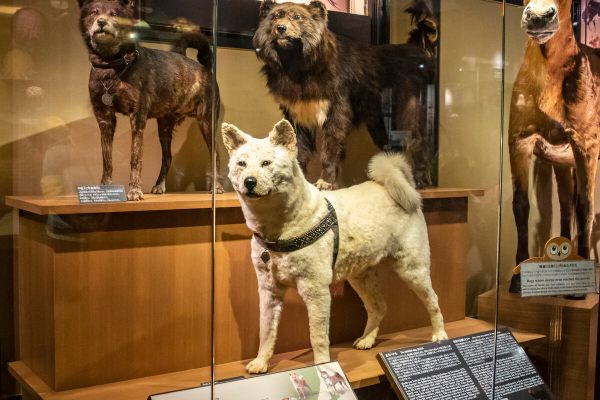An Emblem of Extinction, Lonesome George Goes on Posthumous Display in NYC
Lonesome George at the American Museum of Natural History in NYC (all photographs by Michelle Enemark)
With a neck that stretches for days, the taxidermy of the late, last Pinta Island giant tortoise Lonesome George went on display Friday at the American Museum of Natural History (AMNH) in New York. Standing proud in his own gallery encircled with windows, the symbol of lost biodiversity is on view through January.
Atlas Obscura paid Lonesome George a visit this past Sunday, joining the small throng of a crowd with their cameras angled over the weathered skin and saddle-backed shell of what was arguably the world’s most famous tortoise. Lonesome George — named as such for being the last known member of his subspecies of Chelonoidis nigra abingdonii, as well as totally uninterested in mating with female tortoises — passed away on June 24, 2012, at an age estimated over a hundred years old, in the Tortoise Breeding and Rearing Center. He’d lived at the Galápagos Islands center since he was discovered in 1971, which was after scientists had believed the Pinta Island giant tortoise extinct.
Now, although his loss was mourned as yet another tragedy in human-spurred extinction, it’s hoped by preserving him in taxidermy he can be a continued icon of conservation awareness. It’s believed there were between 14 and 15 giant tortoise subspecies on the Galápagos prior to human arrival. With the destruction of available flora by feeding pigs and goats introduced by voyagers, not to mention the travelers themselves taking the hardy tortoises along for their own food source on the ships, their populations were wrecked.
In January, Lonesome George will journey in death to Ecuador, rather than to the originally planned Galápagos, as we reported last year. It’s incredibly unusual to know the exact individual who marks the end of an animal, which makes the taxidermy of Lonesome George all the more precious. Like the taxidermy and skeleton remains of extinct animals preserved at the Paris Grande Galerie d’Évolution, he’s now in an afterlife almost on the level of a relic. Eleanor Sterling of the Center for Biodiversity and Conservation at the AMNH explains in a video embedded below:
The last known individual of an entire species is gone because of human activity, and so we think that understanding the plight of the giant tortoises and understanding what happened to the Pinta giant tortoises, and then thinking about how that translates into what we do to take care of the other remaining giant tortoises in the Galápagos and endangered species everywhere, is a really important message for us, and one that I think the individual called Lonesome George can really bring to the public.
Lonesome George is on view at the American Museum of Natural History in New York through January 4.
















Follow us on Twitter to get the latest on the world's hidden wonders.
Like us on Facebook to get the latest on the world's hidden wonders.
Follow us on Twitter Like us on Facebook